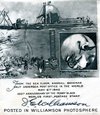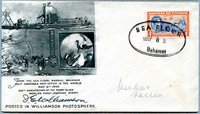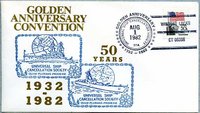Cachet Category Other
Covers should be listed in chronological order. Use
the postmark date or best guess. This applies to covers with add-on cachets as well.
| Thumbnail Link To Cachet Close-Up Image | Thumbnail Link To Full Cover Front Image | Thumbnail Link To Postmark Or Back Image | Primary Date Postmark Type Killer Bar Text Ship --------- Cachet Makers |
|---|
 |
 |
 |
1940-05-06 |
| Cachet Maker |
Notes: Contributed by Mark Kalisch on behalf of Col. & Mrs. Bertram Kalisch, USA (Ret.).
Excerpted from "Candidates for the National Film Registry: With Williamson Beneath the Sea -
Introduction by Brian Taves" [1]
John Ernest Williamson (1881-1966) was active in motion pictures for nearly fifty years and was the pioneer of undersea photography. His father had been a sea captain and inventor of a deep-sea tube, made of a series of concentric, interlocking iron rings, that, when suspended from a specially outfitted ship, created a shaft into the sea allowing easy communication and a plentiful supply of air down to depths of up to 250 feet. In 1912, young Williamson realized that his father's mechanism, intended for underwater repair and salvage work, could be adapted for undersea photography. To facilitate the tube's new purpose, Williamson designed an attachment, a spherical observation chamber with a five-foot funnel-shaped glass window which he called the "photosphere." With a light hung from the mother ship to illuminate the sea in front of the tube, still photographs of the depths off Hampton Roads, Virginia, proved so successful that Williamson was urged to try motion pictures.
The equipment was taken to the Bahamas, where the sunlight reached down to a depth of 150 feet in the clear waters, enhancing photographic possibilities. His first feature was known as the "Williamson Expeditionary Picture"and ingeniously titled THIRTY LEAGUES UNDER THE SEA. Released in 1914, the film demonstrated how the photosphere functioned and the manner in which the Bahamas islanders depended on the life in the sea, climaxing with scenes of Williamson's fight with a shark, which he killed with a knife while remaining within the camera's range.
Through 1955, Williamson continued to shoot both documentary and fiction films in the Bahamas.
Excerpted from "Bahamian Philatelic Literature - Books and other monographs- mainly devoted to Bahamian philately" [2]
Hatton, Denise. "The Bahamas' Sea Floor Post Office of 1939- 40." Linn's Stamp News 70 (August 18, 1997): 36-37. Notes: Review of the Williamson family's exploits in underwater engineering and photography. Details of the sea floor post office and description and illustration of its inaugural first day cover. Account of Gimbell's department store selling sea floor covers commemorating the centennial of the first postage stamp. Illustration of Turks and Caicos Islands' 1997 souvenir sheet depicting the Williamson photosphere.
|
No Image |
 |
 |
1940-05-06 |
| Cachet Maker |
Notes: This is a closeup of the postmark from the above cover.
 |
 |
No Image |
1982-08-01 |
| Cachet Maker |
Notes: USCS 50th anniversary.
Cachet is thermographed.
If you have images to add to this page, then either contact the Curator or edit this page yourself and add them. See Editing Cachet Category Pages for detailed information on editing this page.
Copyright 2025 Naval Cover Museum